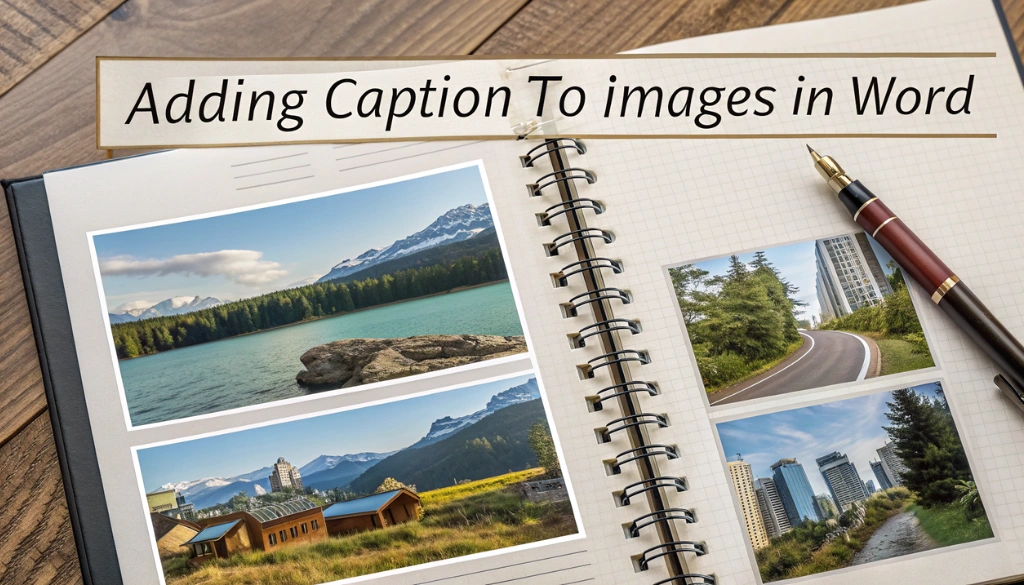Adding captions to images in Microsoft Word is both straightforward and powerful. Captions deliver critical information, enriching the understanding and context of your document.
This guide will show you how to insert captions efficiently. You’ll find the steps to add captions, choose styles, and position them effectively. If you’re creating a report or a school project, captions improve your visuals and improve accessibility for all readers.
Steps to Add Captions to Images in Word
To add captions to images in Microsoft Word, follow these simple steps. Initial, select the image you want to caption, whether it’s a photo or graphic. Then, steer to the References tab on the Ribbon and click on Insert Caption.
A dialog box will pop up, allowing you to choose a label for your caption, such as “Figure” or “Table.” You can also create a new label if needed. After entering your caption text, select its position—above or below the image. This placement is critical for effective document formatting and accessibility.
Captions serve as image descriptions that improve visual storytelling. They provide necessary context and improve document accessibility for all users. If you want text to wrap around the image, adjust the layout options before inserting the caption. This ensures your multimedia documents look professional and organized.
Once you’ve added captions, you can easily update them if you change the order of images or add new ones. For more tips on managing document editing features, check out paragraph spacing techniques.
Selecting the Image
To add image captions in Microsoft Word, start by selecting the image or object. Steer to the References tab and click Insert Caption. In the caption field, provide a clear image description. Choosing the right caption positioning is necessary for effective document formatting.
Increase accessibility by adding alternative text to your images. This helps users understand the image’s context, which is critical in digital publishing. Make sure the caption accurately reflects the image’s purpose and adheres to publishing standards.
For a polished document design, focus on caption styles. Consistent typography enhances professionalism. After inserting the caption, adjust its position to fit your layout. To group the caption with the image for easier movement, select both and use the grouping feature.
Remember, captions can include reference numbers, which are particularly useful in academic writing. This keeps your image annotations organized and easy to reference. For more tips on document editing, check out our guide on font issues that may arise during the process!
Using the Insert Caption Feature
Using the Insert Caption feature in Microsoft Word is necessary for adding image captions that improve document formatting and accessibility. Begin by selecting the object—whether it’s a table, figure, or equation. Next, steer to the References tab and click on Insert Caption.
A dialog box will appear, allowing you to choose a label and position for your caption. For example, select “Figure” for images to effectively organize your visual content. After entering your caption text, click OK. This process not only aids in image annotation but also ensures adherence to publishing standards.
Captions provide critical image descriptions that improve document accessibility, enabling visually impaired users to understand the context of graphic elements. You can also customize caption styles to match your document design preferences.
To further improve your document editing skills, explore additional formatting tips that can lift your in general document quality.
Effective caption positioning not only improves text flow but also enriches the visual storytelling in your documents. By following these steps, you create a more engaging and informative experience for your readers.
Customizing Caption Text and Style
To customize caption text and style in Microsoft Word, initial select the image or object you want to caption. Go to the References tab and click on Insert Caption. A dialog box will open, allowing you to enter your caption and choose a label type, such as Figure or Table.
Improve the caption’s look by highlighting the text and adjusting its font style, size, and color in the Home tab. This ensures your captions align with the in general document design.
Adjust the caption’s position by selecting “Above selected item” or “Below selected item” in the dialog box. Proper caption positioning is necessary for accessibility and visual harmony in your multimedia documents.
For further improvements, check out best practices for formatting captions. Effective formatting enhances readability and maintains consistency, boosting your document’s professionalism.
At last, group your captions with images for easier image management as you rearrange content. By following these steps, your captions will be both informative and visually appealing.
Best Practices for Image Captions in Word
Adding image captions in Microsoft Word is necessary for improving document accessibility and enhancing the user experience. Captions provide critical context, clarifying visual content. To begin, select your object—whether it’s a figure, table, or equation. Steer to the References tab and click Insert Caption.
When crafting captions, prioritize descriptive text. This ensures that all users, including those using screen readers, can grasp the content. Tailor caption styles to match your document’s typography. For instance, modify the font size or color for better visibility.
Placement is critical. Captions can be positioned above or below images, and proper text alignment enhances readability. To wrap text around an image, adjust settings in the user interface before adding the caption. This step is key for a polished document design.
Keep captions concise yet informative. This balance not only aids in SEO optimization but also makes your documents more engaging. By implementing these best practices, you improve the visual appeal of your documents and improve their effectiveness in storytelling through visual content.
For additional tips on document formatting, explore this layout guide.
Ensuring Accessibility with Alternative Text
Ensuring accessibility in documents requires the use of alternative text for images. This image description allows visually impaired users to understand the content effectively. In Microsoft Word, adding captions improves the user experience by providing clear, descriptive text. Position captions close to the image for optimal readability. For more document design tips, check out add-ins that can help.
Descriptive captions improve both accessibility and SEO optimization. When creating multimedia documents, think about how visual storytelling can be improved with strategic caption placement. This approach fosters engagement for all users, making content more inclusive.
Incorporating caption styles that align with the in general document formatting is necessary. This ensures our image annotation is visually appealing and informative. By prioritizing accessibility, we help create a more equitable digital publishing place.
Positioning and Formatting Captions for Clarity
When adding image captions in Microsoft Word, focus on their positioning and formatting for clarity. Place captions directly above or below the image to increase readability, allowing viewers to quickly understand the image description and its context.
Use descriptive text to communicate the image’s purpose, especially in multimedia documents where visual storytelling is critical. Including alternative text with captions makes your content accessible to all users.
In Word, inserting captions is easy: select the image, steer to the References tab, and click Insert Caption. This feature ensures a consistent style throughout your document, enhancing in general document design.
Customize caption styles to match your document’s typography. This not only improves aesthetics but also follows best practices for document accessibility. For more tips on enhancing your document, check out using comments effectively.
Effective caption placement and formatting greatly improve user experience. By adhering to these guidelines, you can create visually appealing and informative documents that engage your audience.
Summing up
Adding captions to images in Word boosts clarity and comprehension. Captions improve document readability and improve accessibility for all users. By following these steps, you can create well-formatted captions that lift your visual content. Keep captions simple yet descriptive to provide an engaging experience for your readers.
Frequently Asked Questions
How do I get a caption to stay with a picture in Word?
To keep a caption with a picture in Word, right-click the image, select “Wrap Text,” and choose “In Line with Text.” This anchors them together.
How do I add captions to images in Word?
To add captions in Word, right-click the image, select “Insert Caption,” type your caption, and click OK. Simple as that!
How do you add captions to images in Word?
To add captions in Word, right-click the image, select “Insert Caption,” type your caption, and click OK. Simple and effective!
What is the shortcut for insert caption in Word?
To insert a caption in Word, select your image, then press Alt + Shift + X to open the Insert Caption dialog. Enjoy captioning!

